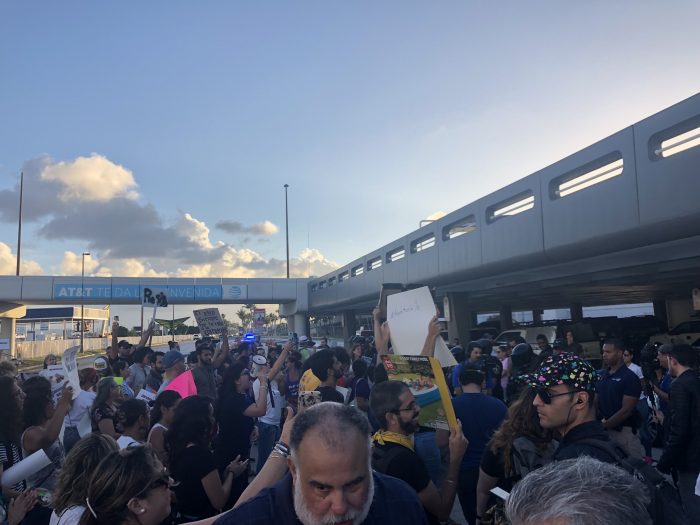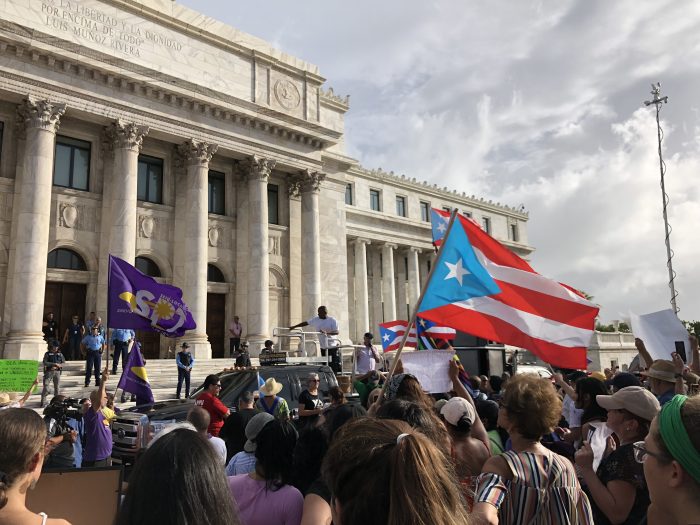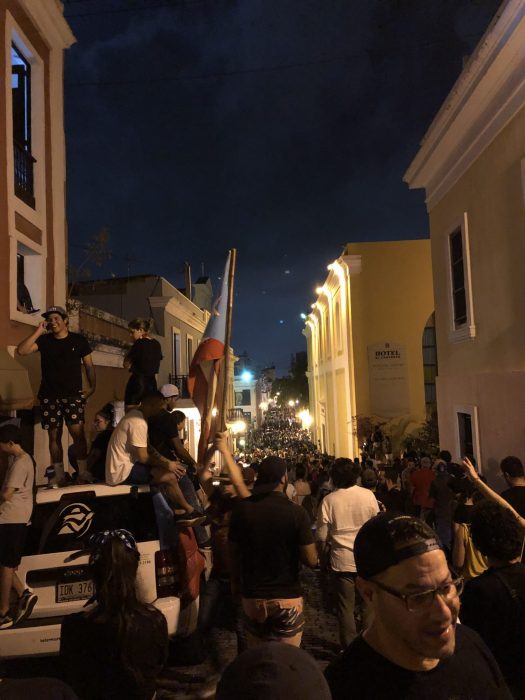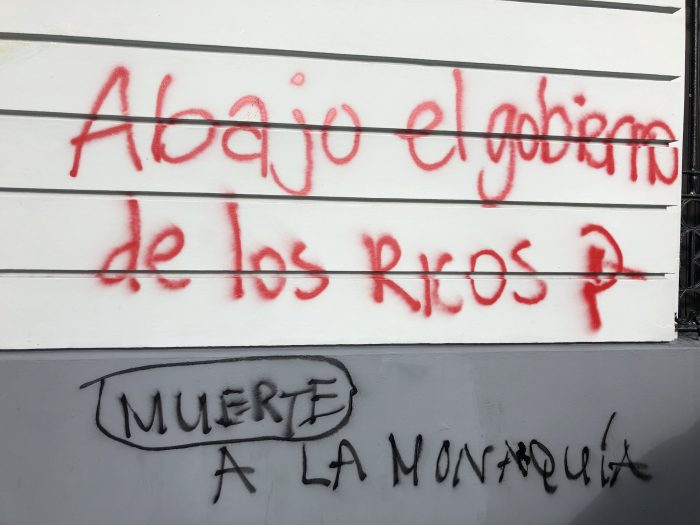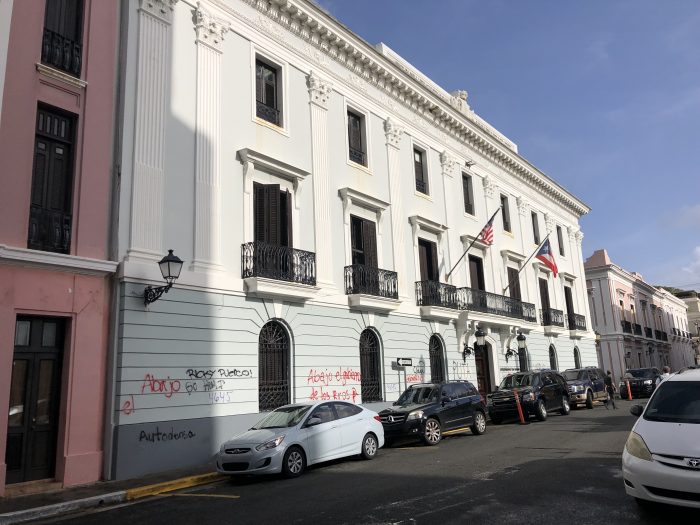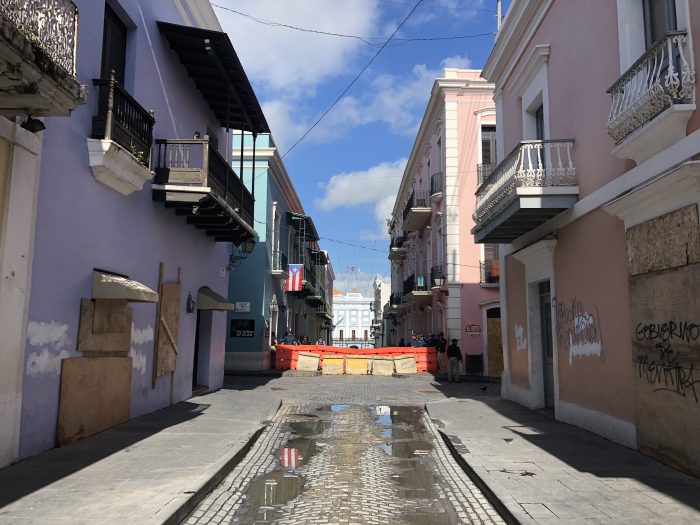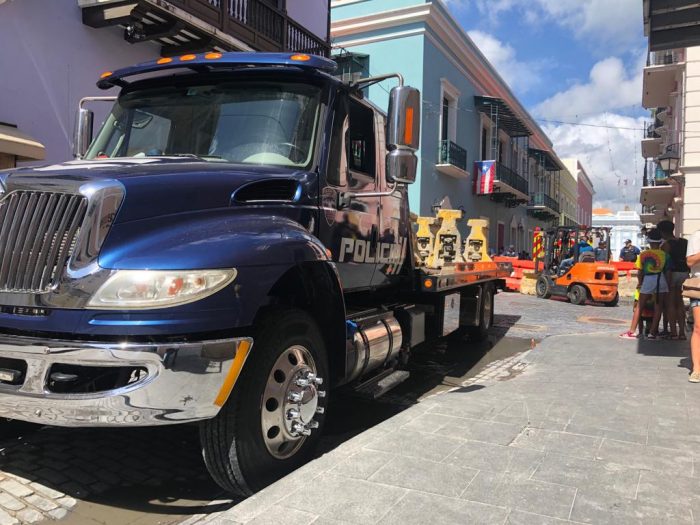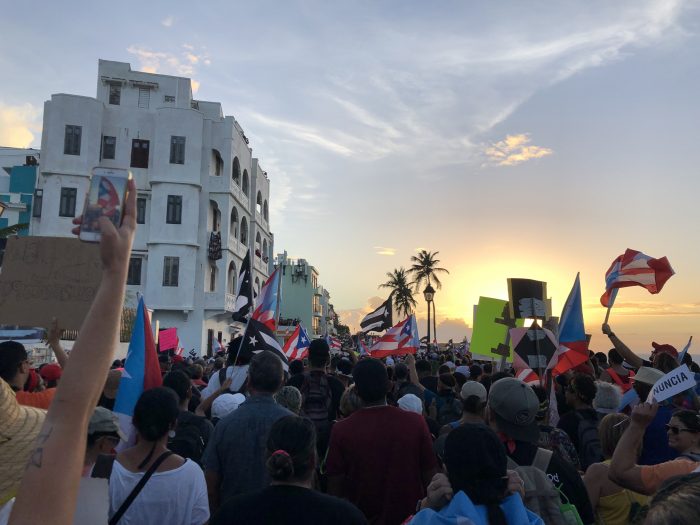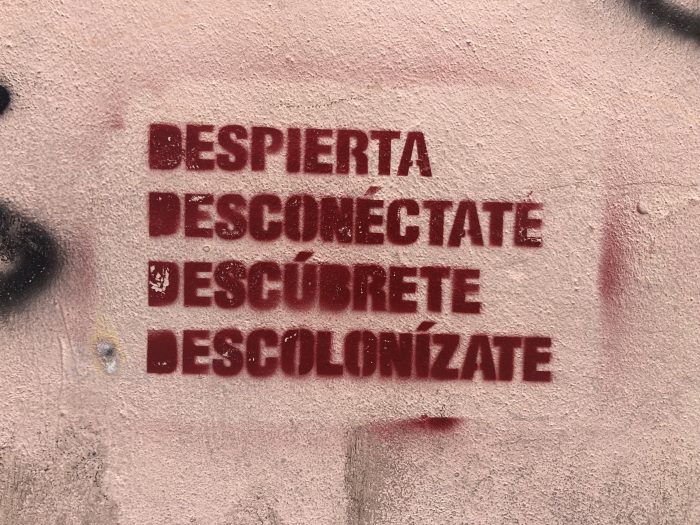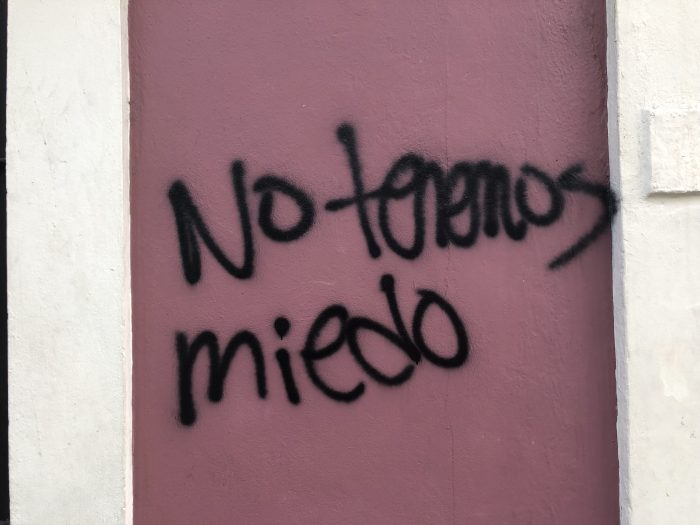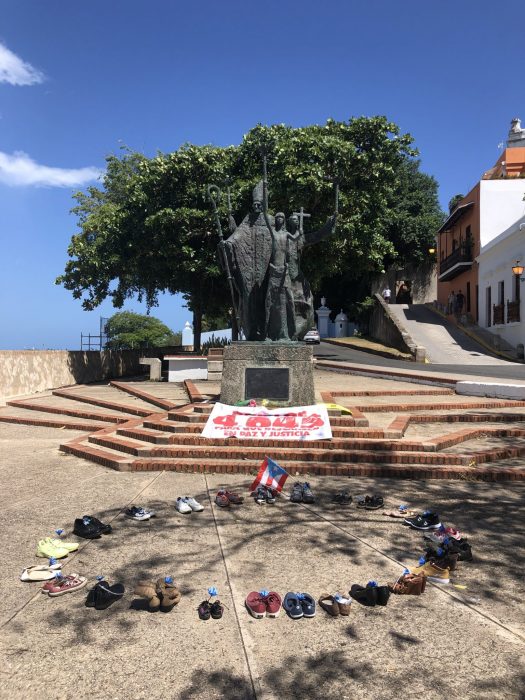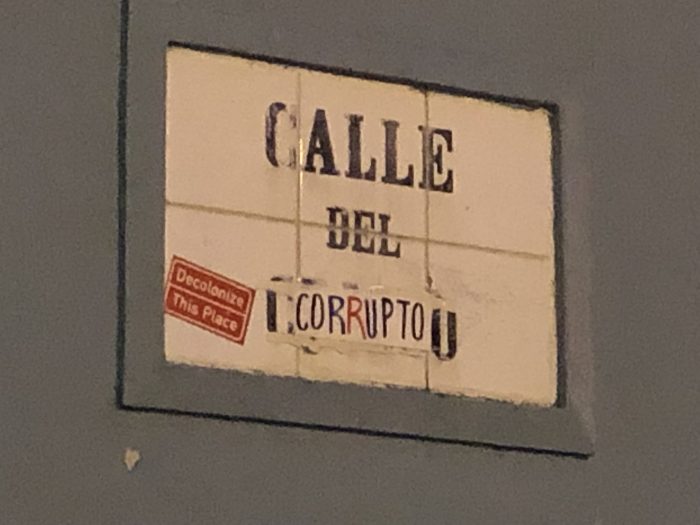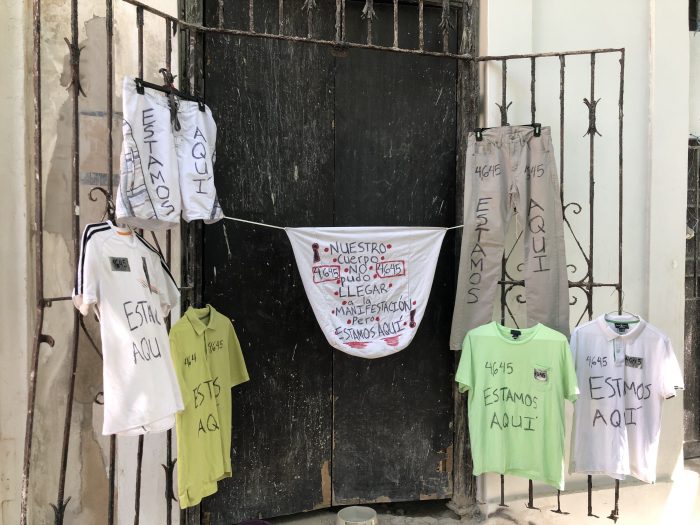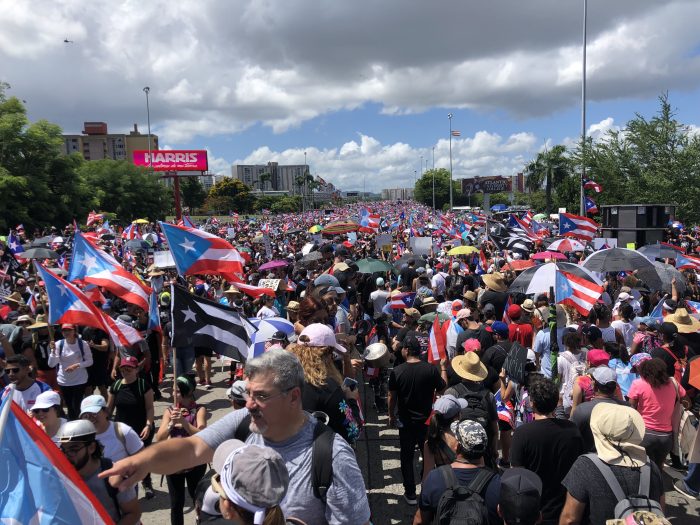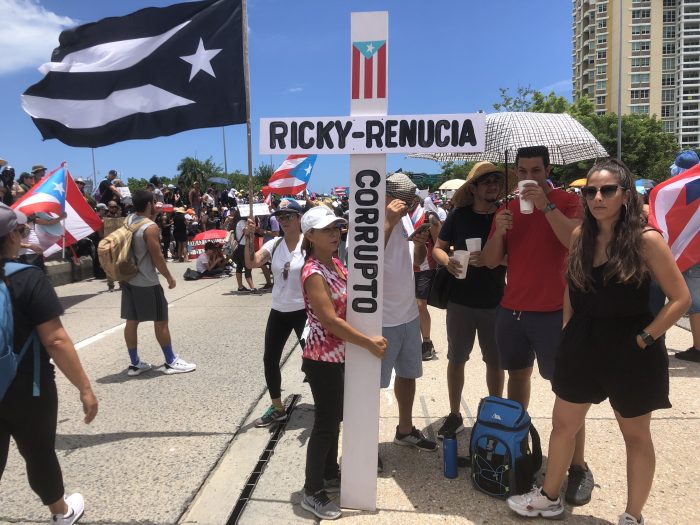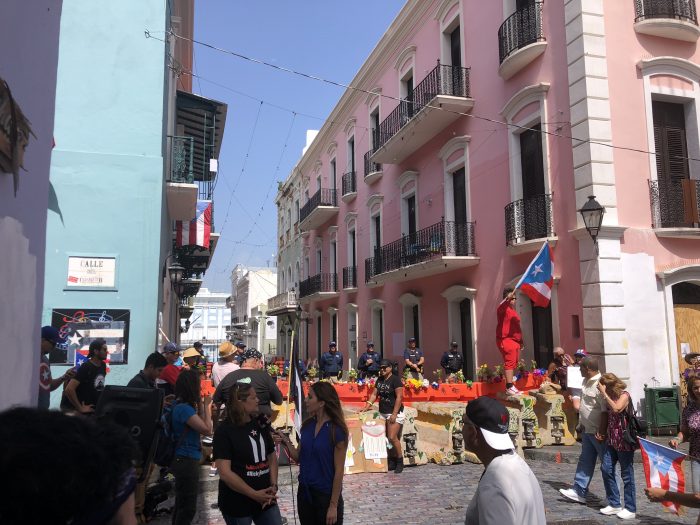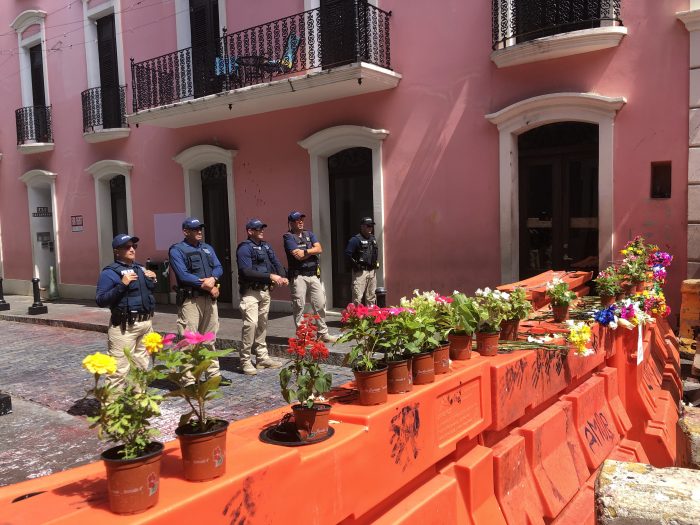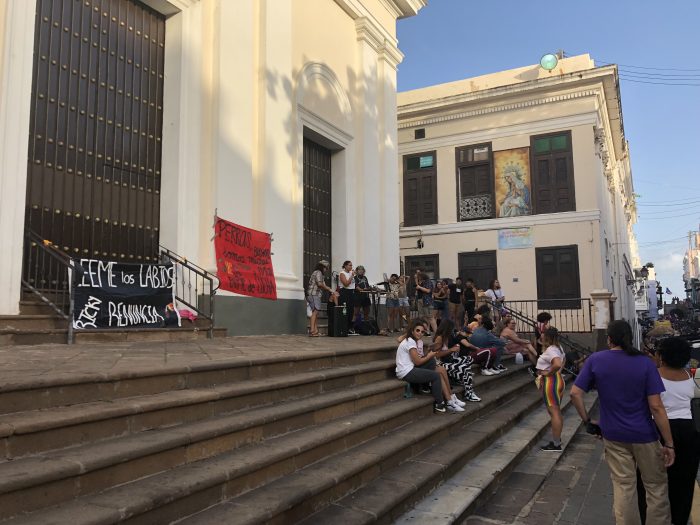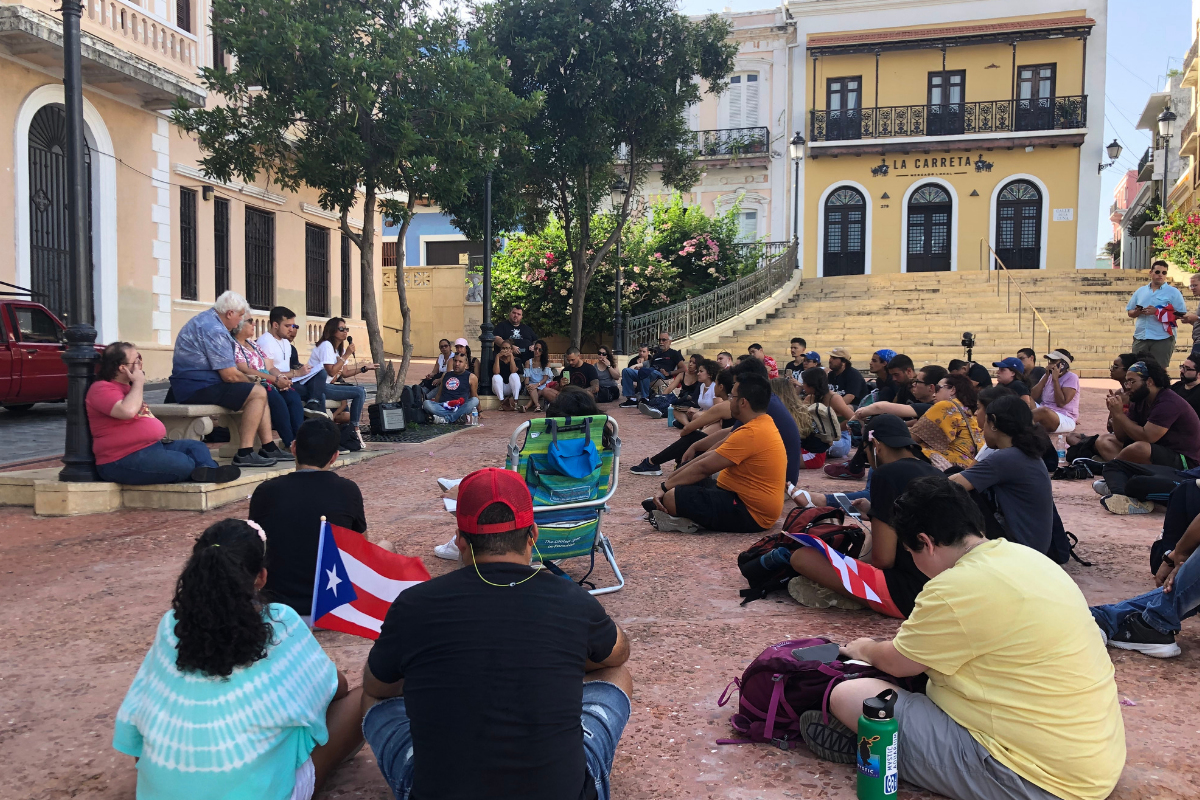

Professors Rosario Rivera and Luiggi Hernánez occupying the Plaza de la Barandilla with a course on Economics History and Psychology of the colonized. (Photo courtesy of the authors)
By Yara Maite Colón Rodríguez, Ph.D. and Luz Marie Rodríguez López, Ph.D.
“Y entonces vi a mi país en la calle. Y mi país en la calle me enamora. […] Nadie, nunca, pase lo que pase, hagan lo que hagan, podrá quitarnos este momento. Puerto Rico, hermoso y nuestro, está en la calle.” – Rima Brusi
Close to twelve midnight, on July 24, 2019, the now-former Governor of Puerto Rico, Ricardo Rosselló Nevares, announced his resignation, effective August 2. This was after twelve days of island-wide protests. Demonstrations responded to six arrests —including that of former Secretary of Education— for mismanagement of public funds as well as the public distribution of a leaked chat where the governor and other high government officials discussed public policy, and other sensitive matters. The chat is filled with sexist, misogynistic, homophobic, and other prejudiced remarks. It highlights as well, strategies geared towards the manipulation of public opinion during the time of relief following Hurricane María. In addition, the conversations contained insensitive jokes about disaster victims, including people who died as a result of the hurricane’s aftermath. Demonstrations continued after the governor’s dismission speech. Protesters celebrated while, at the same time, contested the possible designation of Justice Secretary, Wanda Vázquez, as Governor. Since the Secretary of State also resigned due to his involvement in the chat, she was next in the constitutional line of succession to take the seat as Governor of Puerto Rico.
Analyses on the manifestations’ link to economic, social, and political issues affecting the island are starting to surface. Notwithstanding, there have not been as of yet any informed discussions on the role played by space within the strategies for insurgency. As Puerto Rico was/is framed by a complex set of polycrises –colonialism/coloniality, poverty, the public debt, and the aftermaths of hurricanes Irma and María, among others–, rage, indignation, as well as collective expressions of love and euphoria ignited new types of activism that displayed multiple ways of disobedience against current authoritative body-politics. Manifestations took the form of typical as well as atypically dramatic actions intended to show opposition to oppressive political, economic, religious, and/or educational systems/institutions.
As implied above, the current discussion led by some scholars on the ways in which bodies were turned into disobedient and dissident instruments remains incomplete if the fact that bodies are not, nor do they function, in a vacuum is not taken into account. Bodies in fact, occupy spaces. As Lefebvre suggests, “[a]ny revolutionary ‘project’ today, whether utopian or realistic, must, if it is to avoid hopeless banality, make the reappropriation of the body, in association with the reappropriation of space, into a non-negotiable part of its agenda” (The Production of Space 1991, 166-167). Even if Lefebvre also discusses revolution as essentially an urban effort, in the Puerto Rican framework of the July demonstrations, we must acknowledge that this emphasis on the metropolitan character of the protest was also contested. From the 13th to the 24th (and beyond), citizens participated in several forms of dissent mostly, though not solely, at urban centers or public spaces. Besides city centers, people claimed suburban spaces (private neighborhoods and malls), transportation or infrastructural spaces (bridges, peripheral roads, highways, and airports), and natural spaces (beaches and San Juan’s Bay). All were recognized as sites proper for declaring opposition. Even through virtual spaces (social networks) people were actively channeling indignation into mobilization.
Demonstrations started to organically take place as well, outside of the island, in cities across the United States, Europe, Latin America and other geographies. Thus, it is important to underscore that the protests now being grouped under the umbrella term Verano Boricua (Boricua Summer) showed —when compared to previous attempts— an unprecedented decentralization where the typical tactic of spatial appropriation was atypically embodied through pervasive actions self-convened by several micro-socio-representative samples of citizen’s groupings. The notion of “tribes” seems useful here. In addition, demonstrations were exceptionally organic.
In a turn for the uncanny, bodies engaged in every day and/or ludic activities as forms of protest. Yet, as they were dislocated from every day and ludic places, urban, suburban, and other spaces were redefined, as were the usual relationships between architecture, the city, its citizens, and even the act of opposing itself. Manifestations were place-specific as, consciously and unconsciously, people recognized oppressive sites, memories, and references of power and authority while questioning their logics and identities. Because the Governor was the target, protests began in front of the Palacio de Santa Catalina or La Fortaleza, as it is commonly known. La Fortaleza, located in Old San Juan, was originally a stronghold built in the 16th Century. It has officially served as the Governor’s Mansion since 1845—although the highest-ranking person on the island has lived there from much earlier. Old San Juan is a Spanish colonial walled-city with a typical grid configuration. The hegemonic urban and architectural underpinnings of its colonial history remain visible. It should also be noted, that from 1955 onward —under the leadership of anthropologist, Ricardo Alegría and the recently established Estado Libre Asociado (Commonwealth of Puerto Rico)— Old San Juan was turned into a massive historic conservation project which eventually produced the Disneyfied and museified city tourists engage with today. In other words, the project for the San Juan Historic Zone —a simulated image of a historic city, as defined by Jean Baudrillard— was intended first, as support for Puerto Rico’s incipient tourism industry and then, as part of the grand visions of economic development that followed World War II.
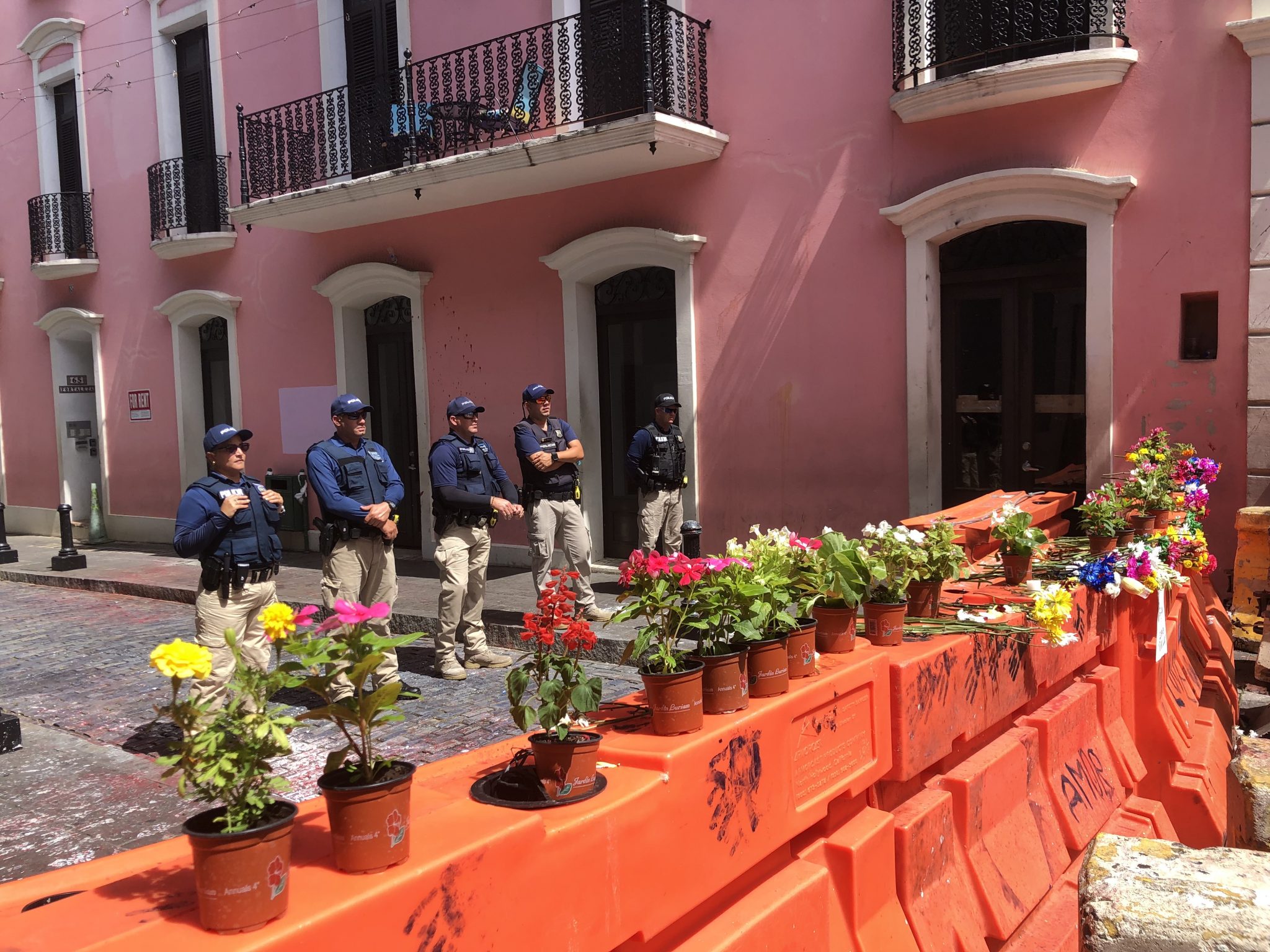

Honoring Marías dead with flowers on plastic barricades, near the entrance of La Fortaleza in Old San Juan, San Juan, Puerto Rico. (Photo courtesy of the authors)
Within the current urbanscape, protests were mostly held in the barrio San Juan—the oldest portion of the city. The original 16th Century settlement includes the Cathedral and its plaza as well as the Governor’s Mansion, which is emplaced off the crossing of Fortaleza and Del Cristo streets. Towards the east, La Fortaleza connects in axis with the Capitol Building, which followed the city’s expansion outside the historic fortifications. After the colonial transfer of Puerto Rico to the United States in 1898, the Capitol was one of the first public projects put into motion outside the defensive Spanish colonial system. Begun in 1907 as a competition for a design to house the island’s legislative and judiciary powers, the Capitol was finally finished in 1929. Historically, El Capitolio, La Fortaleza, and the streets and plazas that connect them have been (and still are) common sites of contestation. For that reason, policies of deterrence against the practices of freedom of speech and free assembly are often instrumented by the powers that be, who frequently try to stop demonstrators by blocking the sites—either with barricades or by the use of police force. As a countermeasure to the silencing and invisibilizing practices enforced by the government, during the July 2019 protests, people organically opted to make their presence felt by taking over the city borders and surrounding sites not only through visual means but also, by deploying other alternative and/or marginal sensory and/or performative forms of expression such as singing, chanting, music playing, pot banging, diving, biking, meditative yoga, reading, teaching, kissing, urban dancing, and horseback and motorcycle riding, among others. Non-combative ludic practices, commonly enjoyed individually or in groups by the people in their roles as private citizens, turned into forms of protest because of their intentional political character, where they were reproduced, and their collective multitudinary dimension.
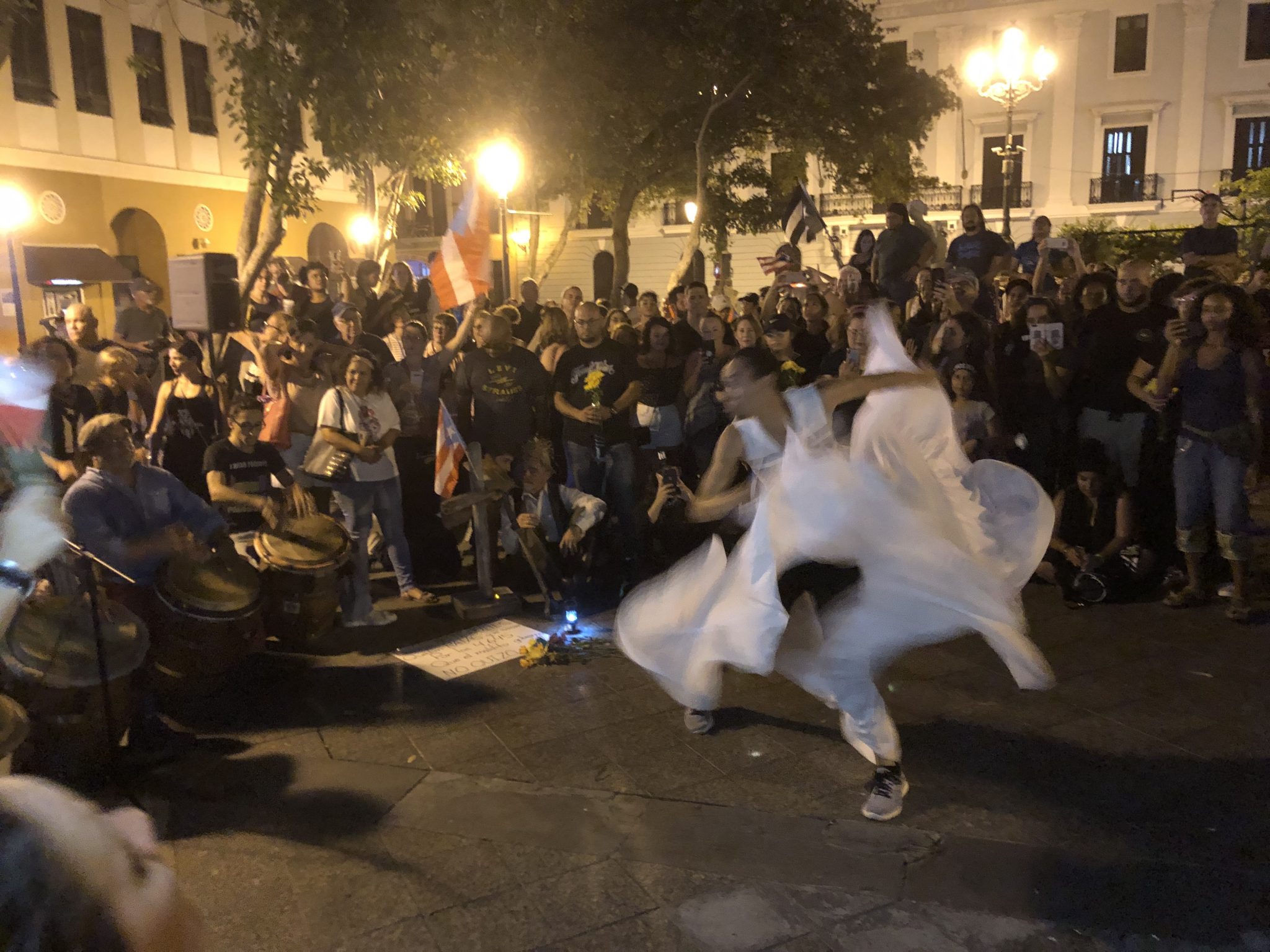

Celebrating Ricardo Rosselló Nevares’s resignation with bomba at Plaza de Armas. (Photo courtesy of the authors)
As explained, spaces chosen as sites for peaceful revolt were those historically linked to colonial rule and other forms of oppression. Such was the case of San Juan’s Cathedral. Recognized as an icon of religious authority, discipline, repression, and censorship, the forms of dissent that took place there included a “grajeada pública” and a “perreo combativo” (a public make-out party and a combative Reggeaton dancing session) across gender lines. The elevated church and its atrium —the first place of congregation within the historical city as well as a visible symbol of the values of the Catholic faith— became the perfect and most dramatic stage for a collective performance against a blatant patriarchal, sexist, misogynistic, and homophobic government, and a consciously and unconsciously biased social fabric. Echoing the ideas of Boaventura de Sousa Santos, this type of alternative protest turned an authoritative space into a democratic site.
As De Sousa Santos puts it, “[p]ublic space has to be rebuilt with a sense of collectivity. It is the space of coexistence, the space of emotion, of trust, it is the space of seeing, and it is the space for hugging. Those are all spaces that must be built and, as such, this space becomes a great conquest at this moment” (Democratizar el territorio, democratizar el espacio, 2013, translated into English by the authors). Through a Facebook post, San Juan’s Archishop later repudiated “the lack of respect shown to the Cathedral… as it represents the transcendental values of our Puerto Rican culture.” In that sense, Lefebvre points to the social consensus the monument displays: a consensus of social norms that are determined by what can happen and that which must not happen within its site (The Production of Space 1991, 36). By performing rituals deemed “obscene” by authority, the feminist and LBGTTTIQ communities brought to light the intolerance of institutionalized religion (and other sectors of society). But more in point, bodies gathered at the Cathedral (re)conquered the space while, at the same time, erasing its monumental status.
As part of the registers of resignification that also took place, soon people started to use the written word as a form of resistance. Vanessa Vilches commented on “the witty, festive, and ludic word displayed on [buildings’ facades], signs, chants and songs. The investment and reappropriation of the chat’s insults show how alive is the word among us” (Ahora la turba, 2019, translated into English by the authors). This is not surprising other than the fact that, as stated earlier, San Juan is a historic city with strong patrimonial regulations. The turning of building facades into public billboards where people expressed anger and indignation, posited a good excuse for authority to define protesters as uncultured vandals who were destroying the island’s historic heritage. Using the arguments of social and urban scholars who study issues of safety, we argue that fear tactics, such as provoking the criminalization and stigmatization of protesters, came into play in order to control the outcome and/or try to defuse the demonstrations (Gema Gardón Clavell, “La ciudad asustada” 2010, 4). Usually, as Jordi Borja contends, the stigmatization of certain groups —commonly, young and poor people— turns them into “suspects” in the public eye (Espacio público y derecho a la ciudad 2012, 14). In the context of Puerto Rico, this is important, because when graffiti, for instance, was identified during the manifestations as acts of vandalism —instead of graphic expressions—, the police and other official sources were able to render fear as a countermeasure to dissent.
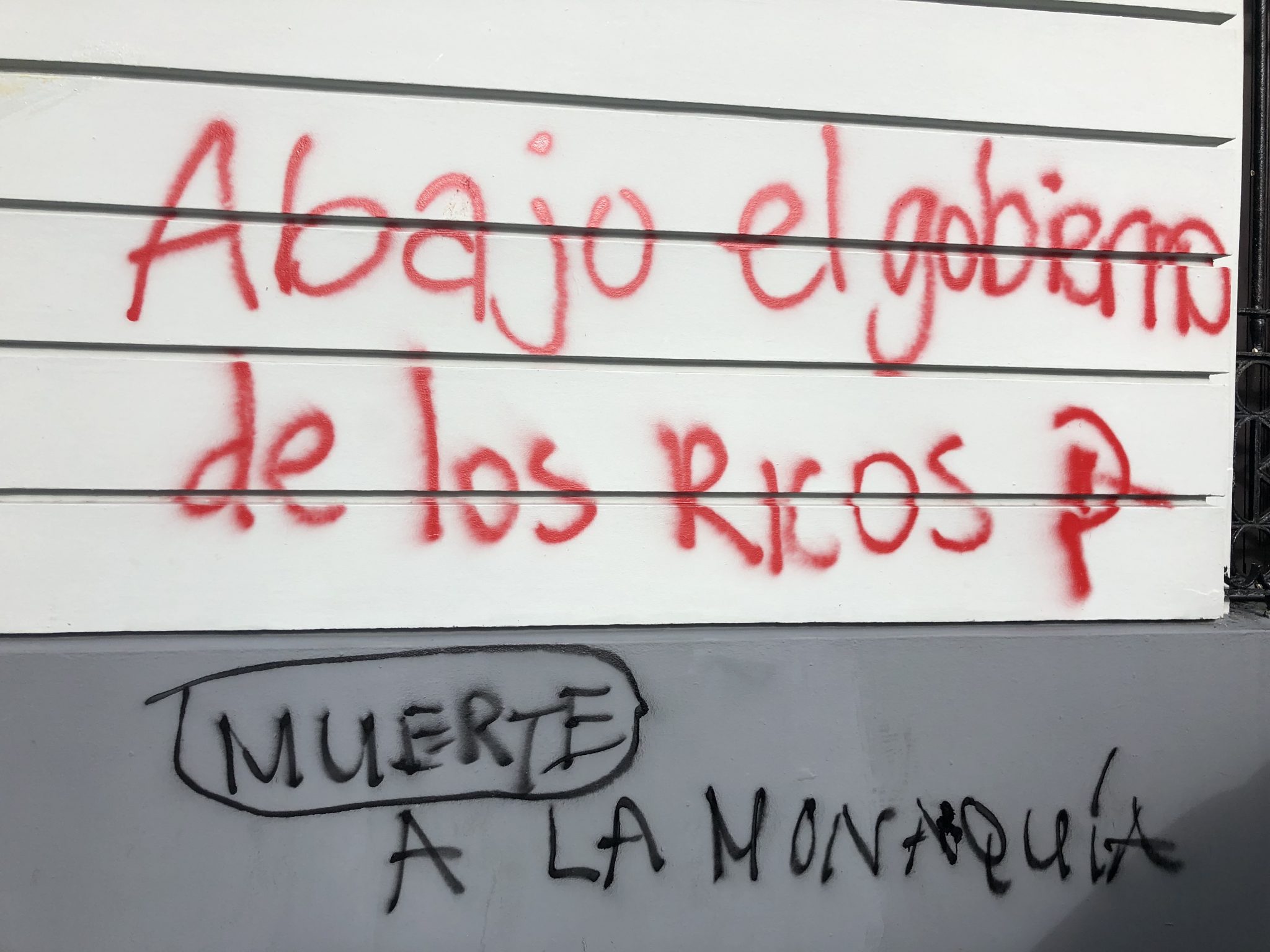

Graffiti on Departamento de Estado’s exterior walls. (Photo courtesy of the authors)
This may explain why some citizens —who were at San Juan also asking for the governor’s resignation— subscribed to the official discourse and actively discouraged and censored demonstrators who used graffiti as a form of expression. Thus, because San Juan is a historic city, a limited notion of heritage became an excuse to demonize the protest. There were, however, two notable exceptions. Beta Local and the Fundación Nacional para la Cultura Popular (National Foundation for Popular Culture) instigated, consciously encouraged, and accepted the timely “tattooing” of their buildings. Both are profoundly aware of the polycrises that affect cultural projects on the island, such as those they head. Besides these two exceptions, however, no patrimonial, government, or academic institution, acknowledged the fact that graffiti could be interpreted as a record; that is, a type of evidence, a form of memory, and a way to register the event. David Harvey recognizes that the relationship of a society with its own past can be that of ignoring it (The History of Heritage 2008, 21). This argument seems to fit the attitude of some people in Puerto Rico during these historic protests. However, as he underscores “[h]eritage resides in the here and now – whenever and wherever that here and now happens to be” (The History of Heritage 2008, 20). In addition, we should not take for granted that, as Borja explains, in some cases place-making starts with a (seemingly) destructive act (Espacio público y derecho a la ciudad, 2012, 8).
For Edwin Quiles, “insurgent urbanism” becomes a critical stance “against the interests of the few over those of the majority.” A minority with power, he argues, limits the rights to the city for the marginalized minority. Thus, “insurgent urbanism supports the struggles of subaltern groups in defending their communities and their access to urban spaces” (Urbanismo insurgente, Vitruvius 2012, translation into English by the authors). Quiles, in addition, recognizes the street as the ultimate scenario for insurgence. “The street,” he says, “is the most important stage that we have for the struggle. […] To appropriate it as a political space, as space of affirmation, is in itself an act of resistance. There, protests, proposals, and alternative visions turn visible and the established order is confronted” (Urbanismo Insurgente, Vitruvius, 2012, translation into English by the authors). Among the activities that took place on the streets during the protests in Puerto Rico, renaming became another act of political insurgence. We must not forget that renaming (and un-naming) was one of the first acts of domination when facing an other. Protesters first renamed the Calle del Cristo as Calle del Corrupto (Street of the Corrupt) and later, Calle de la Fortaleza became Calle de la Resistencia (Street of the Resistance). Calle del Cristo, in turn, became Calle de la Revolución (Street of the Revolution). Demonstrators, thought, did not renamed these streets just in situ but in the internet as well. New pins in virtual mapping projects such as in Google Maps appeared pointing to Calle de la Revolución (Street of the Revolution) as opposed to Calle del Cristo.
Not surprisingly, plazas in the historic colonial zone became venues for other acts of disobedience. We can mention, for instance, a remembrance honoring Hurricane María’s victims at Plaza de la Rogativa. Not only did the act give a palpable presence to the dead —as bodies that were no longer— and the hundreds of families still suffering the loss of loved ones, but it also underlined the fact that these deaths were far from funny —as the previously mentioned chat made them out to be— and that the governor was personally responsible for them. The plaza is strategically located at the southwestern part of the city, at a bastion near one of La Fortaleza’s entrances usually used by the governor to access the Mansion by car. A monument depicting a local myth built around the supposed collective agency of the citizens while under attack by the British stands on the plaza and gives it its name. In 1797 the Bishop, along with several women, gathered in procession while praying for the safety of the city of San Juan under siege. The legend accounts for the retaliation of the British soldiers when —similar to Plato’s Allegory of the Cave— the shadows produced by the light of the torches the people carried made it look as if there were more Spanish troops waiting inside the city. In the same plaza, yoga and meditation exercises became public acts of dissidence during the protest. Peaceful protesters (again, mostly women), in a spiritual act not that far from praying, visualized the Governor’s resignation as part of their combative stance.
Similarly, open classrooms were held at the Plaza de la Barandilla, near the Carlos Albizu University. Following Paulo Freire’s pedagogy of the oppressed and the ideas forwarded by decolonial thinking, young academics (Rosario Rivera and Luiggi Hernández) discussed political-economic history and the psychology of the colonized. At the Plaza del Quinto Centenario and at Plaza de Armas, Bomba dancing became another performative medium to enact the protest. It is a well-known fact that African slaves and their descendants used Bomba as a form of resistance and that their songs were built around a catchy chorus, often used as a way to chronicle, which was then repeated over and over. For the demonstrations held in San Juan, combative slogans became the basis for Bomba songs and dances. Then, in front of the Capitol building, among many acts of defiance toward the Government, feminist groups organized a live reading of the 889 pages in the chat. Another group read the Constitution of Puerto Rico in front of the new “border” checkpoint built by the police in front of La Fortaleza. This, in response to the indications by police officers who, wrongly and repeatedly, stressed that the protections the Constitution allows expired or became invalid around midnight. It was a way to justify consequent acts of overt use of force. Finally, given that the sea was the only remaining access to La Fortaleza, resourceful protesters called for an aquatic manifestation. By collectively and intentionally occupying it, people in boats, kayaks, jet skis, paddleboards, and some divers gathered outside La Fortaleza’s west wall’s bastion and turned the ocean into another site of insurrection.
Other socializing activities —usually relegated from urban spaces— where enthusiasts such as bicycle riders, drivers, motorcycle riders and horseback riders participate, became political when these groups mobilized to the historic city. Not by chance, by abandoning their quotidian spaces —either suburban or rural— these protesters attracted the most attention. Suddenly, the typically marginalized and invisibilized subjects were recognized as citizens with the same rights to the city as other Puerto Ricans. Furthermore, barrio identities and ludic activities —often dismissed, pejoratively addressed, and inferiorized by classism— became legitimate forms of protest. Here, we must underscore another social spectrum that became apparent when the middle class joined in from their private neighborhoods and apartment buildings. Using pot banging as a way to manifest opposition, protesters in suburban areas engaged in collective disturbance from 8:00 to 9:00 p.m. Armed with pots and spoons, suburban dwellers island-wide, vowed to come out every night until the Governor announced his resignation. Hence, it is important to note that it was not their bodies’ volume or visual character which facilitated the occupation of spaces, but the capacity for disruption as loud noise broke night’s silence(s). In gated neighborhoods, apartment blocks, and a highly regulated historic city supported by the economy of tourism, a legal misdemeanor such as “disturbing the peace” was turned by the power of the collective into an efficient form of indignation and rage driven dissent.
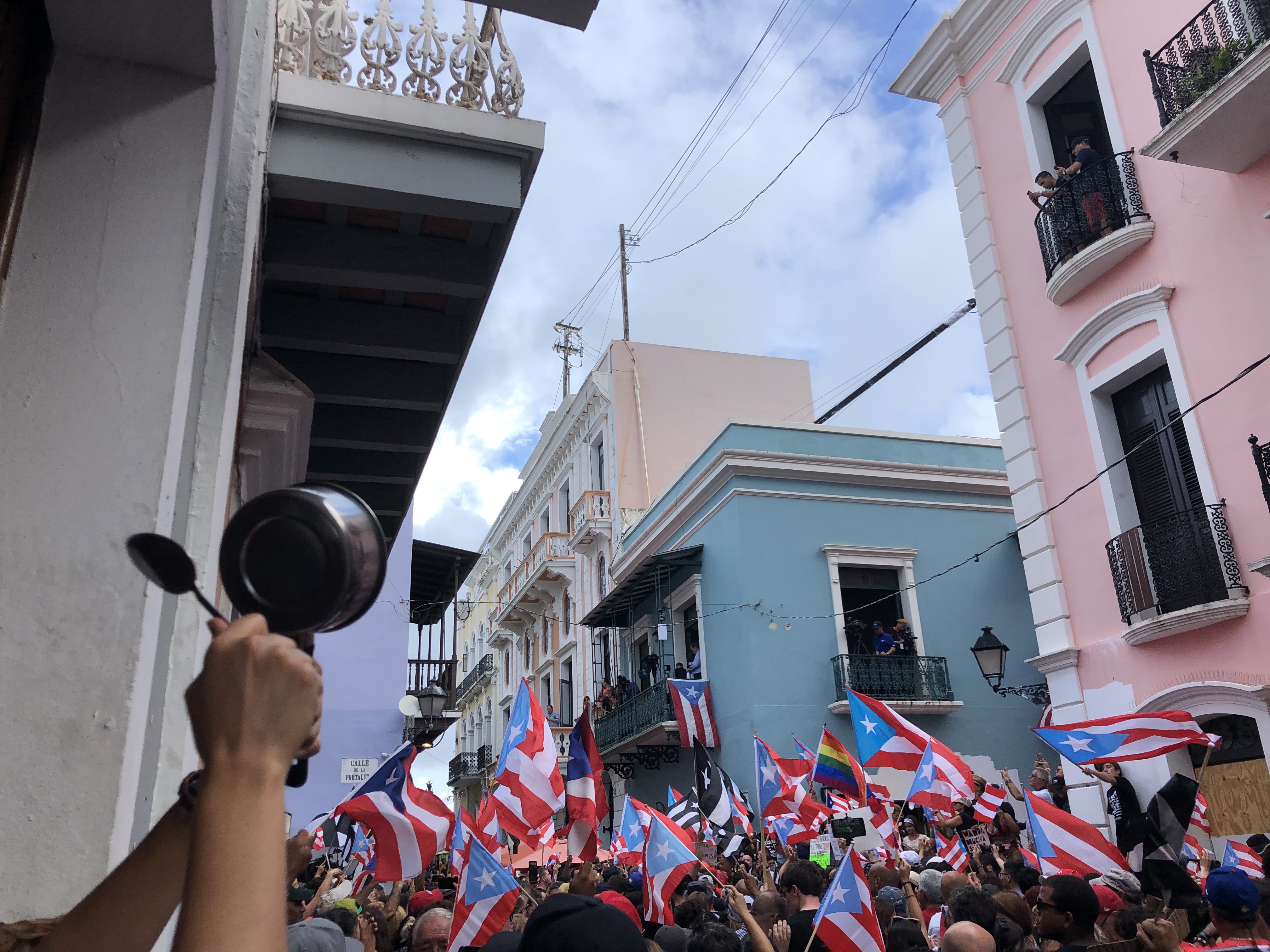

Pot banging on Calle del Cristo on the day of the effective resignation of Ricardo Rosselló Nevares. (Photo courtesy of the authors)
Borja explains that walls —be them police barricades or a historic defensive system such as that of San Juan’s— are not only physically exclusionary but they tend as well, to justify politics of repression that manifest in the way certain groups are treated or the strategies devised to take control of public spaces (Espacio público y derecho a la ciudad, 2012, 8). Perhaps due to an unconscious awareness of the fact that San Juan is a city better suited for repression than for expression, people opted to increase their efforts to make themselves seen and felt by choosing one of the busiest connectors in San Juan’s metropolitan area. Las Américas’ Expressway is, without a doubt, the best example of a site that, by antonomasia, defines modernity, development, and capitalism in Puerto Rico. Five hundred thousand bodies took over this space typically occupied by objects inherited from a failed attempt at urban modernization: cars. Its appropriation by citizens from multiple social classes, races, ages, socio-economic backgrounds, education levels, political and religious affiliations, gendered identities, etc. –on Monday, July 22– was the ultimate expression of insurgence and the final proof of Puerto Rican’s rage and indignation.
Borja is right when he affirms that the city is not only a physical entity but also, a system of relationships. Decolonial theory prefers the term “relational” in order to define a way-of-being-in-the-world that is pluriversal. That is, where everyone lives in solidarity, by strengthening communal associations and diversity instead of individuality and homogenization. For twelve days of contestation, seemingly lived as a festival to the external or colonized gaze, Puerto Rico’s way-of-being-in-the-world shifted in order to work towards the common good. For those twelve days, Puerto Ricans decolonized spaces while decolonizing their minds and, for a short while, society. Twelve days will follow the protests, and twelve more will come after those, and so on. Today, it looks as if there willl be more demonstrations to come. Let us wait and see what takes place and whose bodies keep politically occupying spaces. In the meantime, as we move forward, Enrique Dussel’s words seem appropriate:
“Indignation is necessary, but immediately we must practice it as a participative democracy, which is like the other arm of democracy. […] An unjust order demands chaos as an origin of a new more just order. Dissidence for dissidence’s sake [is not the answer], but the dissidence that emerges against the dominating consensus as the foundation of a better future legitimate consensus” (“Indignados y estado de rebelión”, Vectores de Investigación 2018, 80, translation into English is by the authors).
- First protest at the Luis Muñoz Marín Airport. (Photo courtesy of the auhtors)
- Demonstration at El Capitolio. (Photo courtesy of the authors)
- Protestors taking Calle del Cristo. (Photo courtesy of the authors)
- Graffiti on Departamento de Estados exterior walls. (Photo courtesy of the authors)
- Facade of Departamento de Estado with graffiti. (Photo courtesy of the authors)
- Barricaddes blocking access to La Fortaleza.(Photo courtesy of the authors)
- Concrete barricades in Calle Fortaleza Resistencia. (Photo courtesy of the authors)
- Protesters on their way from El Capitolio to Plaza del Quinto Centenario through Calle Norzagaray. (Photo courtesy of the authors)
- Graffiti on patriomonial building in Viejo San Juan. (Photo courtesy of the authors)
- Graffiti on patrimoniol building in Viejo San Juan. (Photo courtesy of the authors)
- Remembering María’s dead at Plaza de La Rogativa. (Photo courtesy of the authors)
- Renaming of Calle del Cristo as Calle del Corrupto. (Photo courtesy of the authors)
- Art installation inspired by the absence of María’s dead. (Photo courtesy of the authors)
- Paro Nacional in Expreso Las Américas. (Photo courtesy of the authors)
- Protestors asking for the governor’s resignation. (Photo courtesy of the authors)
- Honoring María’s dead with flowers on plastic barricades. Notice the new configuration of barricades after being displaced by protesters. (Photo courtesy of the authors)
- Honoring María’s dead with flowers on plastic barricades. (Photo courtesy of the authors)
- Protestors getting ready for the grajeada combativa at the Cathedral’s atrium. (Photo courtesy of the authors)
As we were getting ready to close this paper three noteworthy acts of counter-resistance have happened that we believe need addressing. The first was the swearing of Pedro Pierluisi as Governor of Puerto Rico just after Ricardo Rosselló stepped down, without being confirmed by both legislative bodies to chair the Department of State—as the Constitution subscribes. He was sworn by a judge at a private residence instead of at La Fortaleza or the Capitol, as accessing into public office should demand. Then, on August 1, the Archbishop led a ”reparation mass” in response to the supposedly offensive and disrespectful “grajeada” and “perreo combativo” that had taken place on July 24. On August 3, an unidentified group painted over with white paint a rainbow-inspired Pórtico de la Igualdad (Equality Porticus), opportunely built during the Pride celebrations as a public relations stunt by the office of the former First Lady, Beatriz Rosselló. Later it was disclosed that members of Mrs. Rosselló’s security and not religious sympathizers were the people involved. The matter is under investigation.
***
Yara Maite Colón Rodríguez, Ph.D. and Luz Marie Rodríguez López, Ph.D. are part of the Colectiva para la Investigación de la Historia y la Teoría de la Arquitectura y el Diseño en Puerto Rico (CIHTAD-PR).



